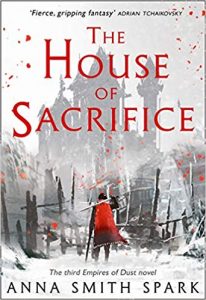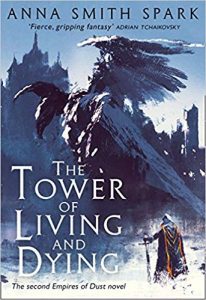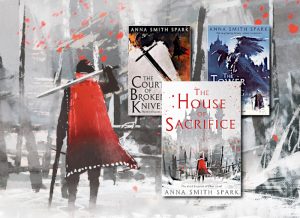THE HOUSE OF SACRIFICE by Anna Smith Spark (Book Review)
 The concluding volume in Anna Smith Spark’s epic and dark debut trilogy rejoins our anti-hero Marith Altrersyr some four years after the events of The Tower of Living and Dying. They have not been quiet years.
The concluding volume in Anna Smith Spark’s epic and dark debut trilogy rejoins our anti-hero Marith Altrersyr some four years after the events of The Tower of Living and Dying. They have not been quiet years.
The allusion to Alexander the Great – the first “world conqueror” – is still there as Marith, his captains and his army wage a ceaseless campaign to subdue the whole of Irlast. His relentless aggression also echoes Charles XII of Sweden in the paralysis of fear that his mere name induces in his enemies. But Charles ultimately pursued one siege too many and was killed by his own side weary of constant warfare on the slightest pretext, and one wonders how far Marith can manage to avoid exhausting his army – or the world.
However, Marith’s ambition and aggression spills over beyond the mere empire building of those two historic generals. He may not quite share all of the Roman Emperor Caligula’s vices, but there is the same decadent disregard for life as the man who was as likely to have a woman’s neck sliced through as admire it simply because he could, the same randomness that had Caligula make his horse into a senator. Marith is a man around whom no one can feel safe. His every whim is a demand to be completed at any cost on pain of death, be it defying building regulations to raise a fortress in a handful of weeks, or slaughtering innocents to raze a town in a handful of days.
This makes it hard to understand his appeal as a character. But – besides those ancient warriors and tyrants – there is another more contemporary analogue for Marith. Those of you who have watched the TV series “Killing Eve” will have met Villanelle – the whimsically lethal female assassin. There is much of Marith in Villanelle and of Villanelle in Marith. They share a seductive sociopathy, a thrill in the kill, making an entertainment of death. As viewers, we knew we shouldn’t like Villanelle, but we did; as readers, we know we shouldn’t like Marith – he does some terrible things – but we do still like him.
As with Killing Eve, there is a love engine at the heart of The House of Sacrifice. Thalia and Marith are not quite so much on opposite sides as Eve the secret service agent and Villanelle the assassin were. However, there is still that fascination that Thalia holds over Marith and the ambivalence in their relationship for Thalia at least knows something of evil. While we get to follow several point of view characters, it is only with Thalia that we are given the intimacy of a first-person perspective – a voice speaking directly to the reader.
Marith and Thalia’s lives and love are not invulnerable, and when tragedy strikes it is Thalia who says to us:
I weep. Marith weeps and howls. We cannot make any human sound.
But admit it: somewhere, deep down, you think that we deserve this. You believe we deserve this.
One of Smith Spark’s many achievements in this series is to convey the charismatic allure of an utterly murderous bastard. We ride in his head and see the almost childish simplicity of his ambition, the disregard for others that is beyond casual. Without that vibrant charisma it would be impossible to understand the hold Marith has over his followers – the toxic combination of love and fear, the ultimate in abusive relationships between one man and an entire army.
Smith Spark paints a vivid brutal picture of war – not so much the broad brush strokes of strategy and tactics. Marith and his army follow military strategy only slightly more systematically than a swarm of locusts. Smith Spark’s eye for detail is in the bloody carnage of hand-to-hand-to-hand combat, of pounding hearts, of utter personal chaos, stab, punch, push – a relentless and intoxicating vision of battles and the sack of cities.
Marith’s generalship is crude, built around personal heroism as the diamond-sharp point of the spear that breaks his enemies’ ranks, and the meat-grinding gambit of throwing more bodies into the breach than even Shakespeare’s Henry V envisaged. Those who fall injured in following him get little solace beyond a place to quietly (or not so quietly) rot, yet even in their agonising death throes they still proclaim their love and loyalty.
Perhaps the answer to the question why Marith is followed so ardently is that he is immortal. Who could not follow not just the king of death but the virtual god of destruction? He wasn’t always immortal, but events and the bitter experience of those who tried and failed to kill him have given Marith a certainty in his own invulnerability that is more secure and better evidenced even than Macbeth’s after the witches’ prophecy.
So what does a murderous immortal king of death have to live for when all fear is removed? Well, there are the endless drinking games, the companionship of his captains, and of course there is Thalia, once High Priestess of Sorlost and the most beautiful woman in the world.
 Throughout the second book in the trilogy, The Tower of Living and Dying, the parallel story of what was happening in Sorlost ran along beside – but separate from – that of Marith’s adventures cutting a bloody swathe through Northern Irlast. In The House of Sacrifice the two streams drift inexorably together as circumstances conspire to drive Marith and Thalia back towards the decadent and decaying city that first threw them together, both victims of an entirely human conspiracy. Like a dog returning to its vomit, or a dragon to its desert, Marith and Thalia seek answers to questions abandoned in their haste to leave. Smith Spark tightens the drawstrings of her story as Marith and Thalia come full circle in a circuit as smoothly complete and satisfying as the unbroken bronze walls of Sorlost itself.
Throughout the second book in the trilogy, The Tower of Living and Dying, the parallel story of what was happening in Sorlost ran along beside – but separate from – that of Marith’s adventures cutting a bloody swathe through Northern Irlast. In The House of Sacrifice the two streams drift inexorably together as circumstances conspire to drive Marith and Thalia back towards the decadent and decaying city that first threw them together, both victims of an entirely human conspiracy. Like a dog returning to its vomit, or a dragon to its desert, Marith and Thalia seek answers to questions abandoned in their haste to leave. Smith Spark tightens the drawstrings of her story as Marith and Thalia come full circle in a circuit as smoothly complete and satisfying as the unbroken bronze walls of Sorlost itself.
Waiting in Sorlost is Orhan Emmeneth and his estranged lover Darath Vorley. One of the most touching motifs in Smith Spark’s writing is the way she conveys Orhan’s utter besottedness with his beloved Darath as the two of them drift into middle age, still tugging at political strings, still manipulating foes at home and abroad with the wealth of the only city to defy Marith’s antecedent Amrath.
Along the way, bobbing with other camp followers in the wake of Marith’s army, is Tobias the sellsword – always the conducting rod that grounds the story in vulgar reality. Here, he’s till dispensing old sellsword wisdom and crude innuendo, only this time with healthy helpings of porridge as the weight of his wounds has rendered him unfit for the front line.
We also follow Landra Relast – murderous nemesis of Marith, sister to his first love and first victim, Carin, and the one whose chance encounter in a shop in Sorlost pitched Marith and the world on a bloody collision course. For four years Landra has tried to work out her vengeance, but blood and destruction still cumber all the parts of Irlast, and Marith is far from being the mere bleeding piece of earth she wishes he’d become.
The House of Sacrifice is a convention-challenging epic fantasy. In its final scenes it reminded me of the closing of Audrey Niffenberger’s “The Time Traveller’s Wife” – another epic love story seeking to close its circle.
At times The House of Sacrifice feels more like literary fiction, glorying in descriptions of the moment more than pursuing some earth-moving resolution of its characters’ flaws or its plots’ conundrums. However, Smith Spark’s fluid writing sustains the reader throughout, flowing like molten bronze as it carries all before it towards a chaotic but deeply satisfying closure.

